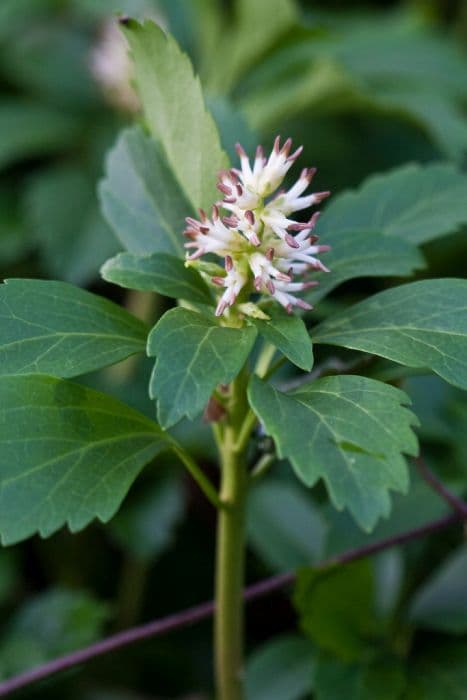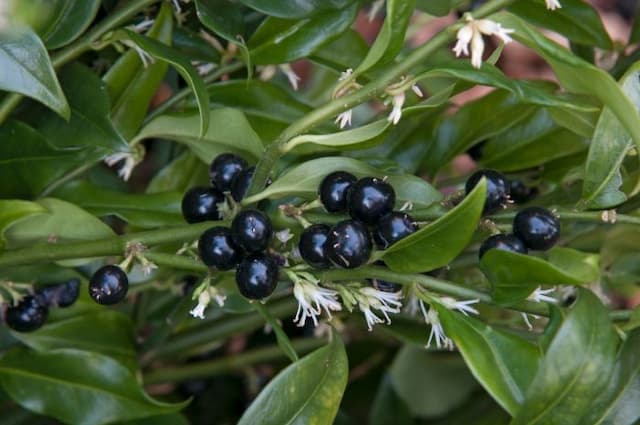Sweet Box Sarcococca hookeriana var. digyna 'Purple Stem'

ABOUT
The plant known as Sweet Box is a captivating evergreen shrub that provides year-round visual interest to any garden space. It boasts a unique combination of features that make it both attractive and versatile. One of the most striking aspects of the Sweet Box is its stems, which showcase a rich purple hue. This deep coloration sets it apart from the more common green stems found in many other plants and adds a touch of elegance and visual depth. Adding to its appeal are the glossy, lance-shaped leaves that adorn the branches. The leaves possess a deep green color that contrasts beautifully with the purple stems, creating a delightful interplay of colors that can enliven any setting. These leaves are arranged alternately along the stems, contributing to a dense and lush appearance. During the winter season, the Sweet Box comes into its own with its bloom. Small, white flowers emerge, releasing a delightful fragrance that fills the air and signals the colder months' arrival. The tiny, inconspicuous blooms may not be showy, but they pack a potent aromatic punch that's sure to draw in the senses. Following the flowering period, the plant produces black berries, which provide an additional layer of visual interest. These berries can stand out against the dark foliage, creating a striking contrast that can be especially captivating in winter's subdued landscapes. Overall, the Sweet Box is a visually appealing plant that combines a variety of colors and textures to full effect. Its purple stems, glossy green leaves, fragrant white flowers, and black berries all come together to create a stunning display that can enhance any garden throughout the year.
About this plant
 Names
NamesFamily
Buxaceae
Synonyms
Sweet Box, Himalayan Sweet Box, Purple-Stem Sarcococca
Common names
Sarcococca hookeriana var. digyna 'Purple Stem'.
 Toxicity
ToxicityTo humans
Sweet Box is generally considered non-toxic to humans. There is no significant threat posed by accidental ingestion of small quantities, and no notable symptoms of poisoning are commonly reported associated with this plant.
To pets
Sweet Box is also regarded as non-toxic to pets. It is not known for causing any significant, adverse health effects if pets consume parts of it. As with any non-food plant, ingestion could potentially cause mild gastrointestinal upset, but serious poisoning is unlikely.
 Characteristics
CharacteristicsLife cycle
Perennials
Foliage type
Evergreen
Color of leaves
Green
Flower color
White
Height
3-5 feet (0.9-1.5 meters)
Spread
3-5 feet (0.9-1.5 meters)
Plant type
Shrub
Hardiness zones
6-9
Native area
China Himalayas
Benefits
 General Benefits
General Benefits- Ornamental Value: Adds visual interest to gardens with its evergreen foliage and purple stems.
- Fragrant Flowers: Produces small, fragrant white flowers in winter, providing sensory appeal during a season when few plants are in bloom.
- Shade Tolerant: Thrives in shaded areas where many other plants might struggle.
- Low Maintenance: Requires minimal care once established, making it ideal for gardeners of all skill levels.
- Drought Resistant: Can withstand periods of low rainfall once established, reducing the need for frequent watering.
- Wildlife Attraction: The flowers provide nectar for pollinators, while the berries can be a food source for birds.
- Compact Growth: Suitable for smaller gardens or landscaping areas due to its manageable size.
- Year-Round Interest: Retains its foliage and structure throughout the year, offering continuous appeal.
- Erosion Control: Its dense growth habit can help stabilize soil on slopes or banks.
- Deer Resistant: Generally not favored by deer, which can help prevent damage to the plant in areas with deer populations.
 Medical Properties
Medical PropertiesThis plant is not used for medical purposes.
 Air-purifying Qualities
Air-purifying QualitiesThis plant is not specifically known for air purifying qualities.
 Other Uses
Other Uses- Sweet Box can be used in perfumery for its sweet fragrance, extracted from its tiny but significantly scented flowers.
- The dense foliage of Sweet Box is beneficial for providing a protective habitat for nesting birds and other small wildlife in the garden.
- Its evergreen leaves can be used in floral arrangements and wreaths, offering a touch of green throughout the year.
- Sweet Box wood, being dense and hard, could be used in crafting small objects such as inlays for wooden boxes or decorative carving, although this is not a common use.
- The plant's ability to thrive in shade makes it an excellent natural ground cover in darkened garden areas where other plants might struggle to grow.
- Because Sweet Box is resistant to urban pollution, it can be planted as a part of green urban infrastructure to enhance city landscapes.
- The compact growth habit of Sweet Box makes it useful for creating low, formal borders along paths or garden beds.
- Sweet Box can be cultivated as a bonsai, especially by those interested in non-traditional bonsai species.
- When dried, the leaves of Sweet Box can be used as a moth deterrent in closets and drawers, much like lavender or cedar.
- The winter interest of Sweet Box, due to its flowering in late winter, can be utilized in gardens to break the monotony of barren landscapes in cold seasons.
Interesting Facts
 Feng Shui
Feng ShuiThe plant Sweet Box is not used in Feng Shui practice.
 Zodiac Sign Compitability
Zodiac Sign CompitabilityThe plant Sweet Box is not used in astrology practice.
 Plant Symbolism
Plant Symbolism- Purity - Sarcococca, commonly known as Sweet Box, often symbolizes purity due to its bright white flowers.
- Protection - The dense foliage of Sweet Box can represent protection and shelter, offering a safe space or refuge.
- Endurance - With its evergreen leaves and resilience in different soil conditions, Sweet Box is often associated with the ability to endure hardship.
- Victory Over Struggle - As Sweet Box can thrive in shaded areas where other plants may struggle, it symbolizes overcoming adversity.
 Water
WaterSweet Box prefers consistently moist but well-draining soil, so it should be watered thoroughly once the top inch of soil feels dry to the touch. In general, this means watering every 1 to 2 weeks, depending on climate conditions. During the growing season in spring and summer, water with approximately 1 gallon per plant to ensure deep soil moisture. In winter, reduce watering slightly as the plant's growth slows down. Ensure that the soil never becomes soggy, as this can lead to root rot.
 Light
LightSweet Box thrives in partial to full shade, making it ideal for planting beneath trees or in the shadowed corners of a garden. It should be protected from intense midday sun, which can scorch its leaves. East or north-facing spots that receive dappled sunlight are best for this plant, providing it with the soft light conditions it prefers.
 Temperature
TemperatureSweet Box is hardy in a range of temperatures and can tolerate a minimum temperature of around 0 degrees Fahrenheit. The plant can withstand up to about 80 degrees Fahrenheit without stress. The ideal temperature for optimal growth is between 60 and 70 degrees Fahrenheit.
 Pruning
PruningSweet Box should be pruned to maintain its shape and to remove any dead or diseased branches. The best time for pruning is after the plant has finished flowering in late winter or early spring. Pruning every year or two is typically adequate. Remove unwanted branches at their base to encourage healthy new growth.
 Cleaning
CleaningAs needed
 Soil
SoilSweet Box prefers a soil mix with rich organic matter, well-draining and with a slightly acidic to neutral pH, around 5.5 to 7. A mix of garden soil, compost, and perlite or pine bark would be ideal for good drainage and fertility.
 Repotting
RepottingSweet Box should be repotted every 2 to 3 years or when it outgrows its current container, preferably in the spring just before the growing season begins.
 Humidity & Misting
Humidity & MistingSweet Box thrives in moderate to high humidity levels, typically around 40-60%. Consistent humidity is beneficial, but the plant is quite adaptable to average home humidity levels.
 Suitable locations
Suitable locationsIndoor
Place Sweet Box in bright, indirect light and keep soil moist.
Outdoor
Plant Sweet Box in partial shade with shelter from harsh sun.
Hardiness zone
6-9 USDA
 Life cycle
Life cycleSarcococca hookeriana var. digyna 'Purple Stem', commonly known as Sweet Box or Himalayan Sweet Box, begins its life cycle as a seed that germinates in moist, well-drained soil preferably in partial to full shade. Seedlings develop into young plants with a distinctive purple tinge on their stems, and as they mature, they form evergreen shrubs with glossy, deep green leaves. In late winter to early spring, small, fragrant white flowers bloom, which are often followed by the development of black, berry-like fruit if pollination occurs. After fruiting, the plant enters a period of growth where it focuses on leaf and stem development throughout the spring and summer. As a slow-growing shrub, Sarcococca hookeriana var. digyna 'Purple Stem' may take several years to reach its full size, which is typically around 3 to 5 feet in height and spread. During its mature stage, the plant requires minimal maintenance, and with proper conditions, it can live for many years, continually producing fragrant flowers and foliage.
 Propogation
PropogationPropogation time
Early spring
The most popular method to propagate Sarcococca hookeriana var. digyna 'Purple Stem', commonly known as Sweet Box, is by softwood cuttings. This is typically done in late spring or early summer when the plant's growth is most vigorous. Cuttings about 4 to 6 inches long, with a few leaves attached, are taken from the current year's growth. The cut end of the cutting is then dipped in rooting hormone to encourage root development and planted in a mixture of peat and perlite. The cuttings should be kept moist and in a well-lit area but out of direct sunlight until they root, which generally takes a few weeks. Once roots have formed, the new Sweet Box plants can be transferred to individual pots to grow on before being planted out.




